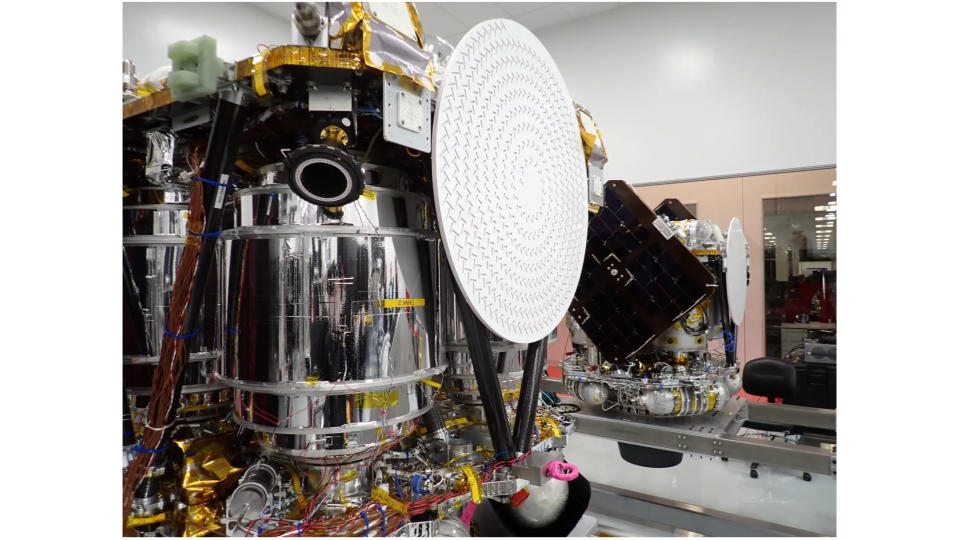When you buy through links on our articles, Future and its syndication partners may earn a commission.


Two Mars-bound smallsats that will fly on the highly anticipated debut of Blue Origin’s New Glenn rocket have arrived at their launch site in Florida.
The satellite duo, known as ESCAPADE (“Escape and Plasma Acceleration and Dynamics Explorers”), are set to launch atop New Glenn no earlier than Oct. 13 from Cape Canaveral Space Force Station in Florida. They’ll arrive in Mars orbit in September 2025, on a NASA mission to study how incoming charged particles from the sun interact with and alter the planet’s magnetic environment.
The two coordinated robotic explorers could paint a more detailed picture of how Mars’ interaction with the solar wind influences the leaking of the planet’s thin atmosphere, and how its climate evolved over time to lose what scientists think was once a plentiful reserve of liquid water on the surface.


On Aug. 18, the twin ESCAPADE spacecraft arrived at the Astrotech Space Operations Facility in Titusville, Florida, to prepare for launch. At the facility, which is owned by Lockheed Martin, teams will check various aspects of the satellites in a dedicated cleanroom, including their electrical circuits and potential leaks in their tanks before carrying out the final assembly.
The spacecraft will be fueled next month, NASA said in a recent statement.
Related: New Glenn: Blue Origin’s big new reusable rocket
“The successful delivery of the spacecraft marks a significant milestone and the culmination of over three years of dedicated teamwork from individuals across the project,” ESCAPADE Principal Investigator Rob Lillis, of the University of California, Berkeley, said in the NASA statement. “Now, we’re thrilled to embark on this first step of our journey to Mars!”
The two small satellites were built by California-based Rocket Lab and UC Berkeley, which is leading the mission and has dubbed the satellites “Blue” and “Gold” after the school’s traditional colors. Each probe weighs under 198 pounds (90 kilograms) and carries three science instruments. The total cost for the mission is less than $80 million, according to the mission website.
The value of the launch contract that NASA signed with Blue Origin is $20 million, SpaceNews reported.
ESCAPADE is among a wave of low-cost, high-risk NASA missions to other planets, which otherwise typically demand over a decade of development and exceed $1 billion in costs. “Sending two spacecraft to Mars for the total cost of $80 million is just unheard of, but current NASA leadership is taking the risk,” Lillis said in a previous press release. “Instead of spending $800 million for a 95% chance of success, can we spend $80 million for an 80% chance? This is what NASA is trying to find out with these missions, and we are lucky to be one of the guinea pigs.”
The satellites were initially scheduled to piggyback on the same SpaceX Falcon Heavy rocket that would loft the Psyche asteroid mission in August 2022. They were removed, however, after delays to the Psyche mission resulted in a new trajectory that didn’t support dropping ESCAPADE off at Mars. (Psyche ended up launching successfully in October 2023.) The satellite duo then became the primary payload onboard Blue Origin’s first orbital rocket, New Glenn, which is a two-stage heavy-lift rocket named after NASA astronaut John Glenn, who in 1962 became the first American to circle Earth.
New Glenn is 322 feet (98 meters) tall, roughly the height of a 30-story building, and is capable of launching roughly 45 metric tons into low Earth orbit. Its maiden flight will come after more than a decade of development by Blue Origin, which was founded by Amazon CEO Jeff Bezos, and over three years later than the company hoped for.
RELATED STORIES:
— See Blue Origin’s New Glenn rocket come together at Florida space coast factory (photo)
— Blue Origin video shows off updated design of huge New Glenn rocket
— Mars: Everything you need to know about the Red Planet
Once the ESCAPADE satellites reach Mars in September 2025, “the mission team will need several months to configure their orbits for science observations,” NASA said in the recent news release. Their orbit will be adjusted over several months such that by early 2026 they’ll follow each other in a “string of pearls” formation, which will allow them to gather data on Mars’ rapidly changing response to the solar wind.
They will later break into different orbits such that they can observe both the solar wind and Mars’ upper atmosphere in real time, according to the space agency. The science mission is designed to last 11 months in Mars orbit, until March 2027.
Meanwhile, the New Glenn first stage is expected to return to Earth shortly after liftoff, demonstrating its reusability. Blue Origin has said that the first stage will operate like a commercial airliner but with cleaner fuel, leading to less waste and lower launch costs.
In recent weeks, portions of other New Glenn rockets scheduled for future flights have suffered damage, Bloomberg reported on Aug. 21. In one incident, the top of Blue Origin’s second New Glenn rocket crumpled “like a crushed Coke can,” partly due to an error by factory workers who had moved the section into a chilled storage hangar but didn’t monitor the hardware afterward. In the second incident, a part of the third New Glenn rocket failed during stress testing and exploded inside a building.
No injuries were reported in either incident, according to Bloomberg, which first broke the news about the recent failures. The issues haven’t affected New Glenn’s planned debut launch in October, a Blue Origin spokesperson told GeekWire’s Alan Boyle.
